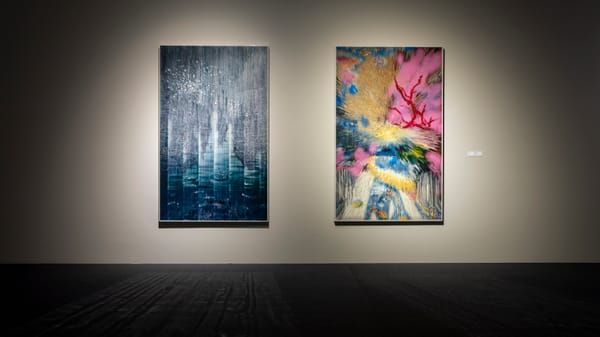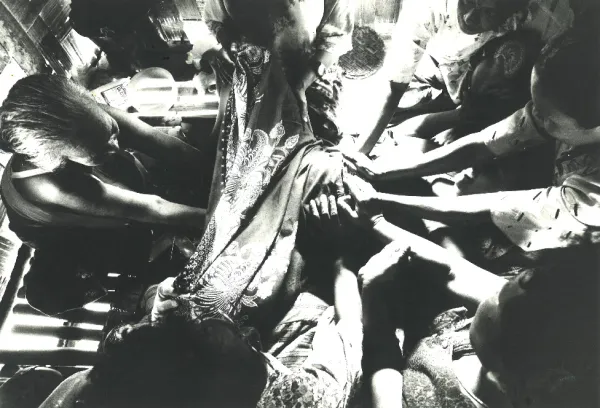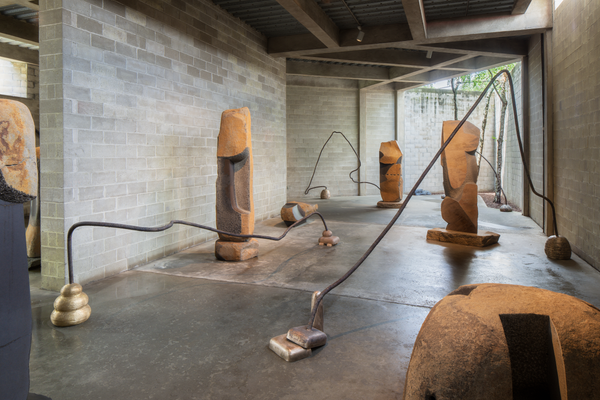Shows
“Mirrors for Princes: Both Sides of the Tongue”



As Slavs and Tatars aficionados know well, every new cycle of work the collective produces culminates in a book. Their latest cycle, Mirrors for Princes, also started with one: the 11th-century Turkic tome Kutadgu Bilig (“Wisdom of Royal Glory”), which is a pillar of the medieval literary genre of leadership “grooming guides” for rulers (think Machiavelli’s The Prince.) Offered to both Christian and Muslim sovereigns-to-be, such books are, in the artists’ eyes, the erudite ancestors of today’s ubiquitous “self-help” guides.
Beyond this unlikely pedigree, two interesting currents are afoot in Slavs and Tatars’s rollicking show at the New York University Abu Dhabi Art Gallery, entitled “Mirrors for Princes: Both Sides of the Tongue,” which is marked by the collective’s telltale brand of brainy humor. First, the artists have honed in on the moment when the secular art of statecraft hoists itself to the level of theology, evoking the uneasy mingling of faith and state that still smolders in places like the United States and the Middle East. Second, language, forever a Slavs and Tatar preoccupation, crops up repeatedly in “Mirrors for Princes,” raising questions about tensions between print and oral traditions. against the background hum of insidious language politics.
Entering the gallery, the visitor is immediately confronted with a secular/religious frontier—the threshold moment when one robes/disrobes to enter a sacred space. The Squares and Circurls of Justice (2014) is a long rail from which hang turbans, tarbouches and sundry regional headgear, conceivably deposited here by “worshippers” within. “Islam radicalized with the arrival of print,” said a Slavs and Tatars member, somewhat startlingly, on the exhibition’s opening night, his hand propped on the hat stand/artwork. As counterintuitive as it may seem, Muslim societies who retained oral traditions (such as Central Asian lands that fell under proscriptive communist regimes) don’t demonstrate the kind of radicalization to which print-prone Muslim countries have been prey. So beyond this threshold, “orality” beckons.
Lektor (2014) is a rare foray into sound for the artists. Nuggets of advice from Kutadgu Bilig, recorded in the Uighur language (in which the text was originally written), emanate from mirrored rahlés (V-shaped book stands). The recording is simultaneously voiced over in other languages (including Arabic) on different rahlés by recitation professionals—a peculiar exercise in both respecting and disrespecting these texts intended to sensitize future princes to the importance of language.


While the reflective rahlé/speaker component of Lektor crystallizes the print/oral tension, Nose Twister (2014), a curvaceous sofa-like structure, speaks of a vanished letter in the Turkish language—a “kaf” crowned by three dots—and its corresponding nasalized sound, which has been equally extinguished. Cleverly crafted to resemble the extinct letter, the installation, seen from the side, is also shaped like a nose (allegedly inspired by that of Azeri painter Tahir Salahov’s wife). Nose Twister is intended to be used—sat in, climbed over, leant on—and on opening night visitors navigated it with the same glee one imagines an early Siah Armajani structure might have elicited, romping about and wondering what makes it art. Nearby, Mystical Protest(2011), one of the earliest pieces in the show, works like a counterpoint to the wise advice proffered by the Kutadgu Bilig: painted over the repetitive patterns of Shi’a muharrem fabric, a fluorescent text praises the importance of repeating mistakes.
For all the show’s playfulness, a crisp grammar regulates its organization. Following the section that explores language, we are led to works about ritual, in a darkened area in the gallery devoted to the act of grooming. This space, too, holds its share of intellectual chuckles, like the work Bandari String Fingerling (cloud) (2014), comprising prayer beads poised to perform hair removal by “threading.” Zulf (brunette) (2014), a rahlé with twin tufts of hair cascading down its sides, underscores the role that books play in the “grooming” of the self—a sly nod to the very tome that sparked “Mirrors for Princes” in the first place.
Abu Dhabi is the second stop of the roving, five-city show, which was initiated at the Kunsthall Zürich. Ending on May 30, 2015, at NYUAD Art Gallery, “Mirrors for Princes” will head to Edinburgh, Brisbane and Houston. Each iteration will add a local language to the Lektor voice-overs, and will also feature a different exhibition curator.







